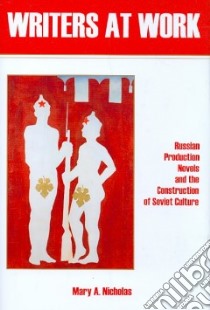Writers at Work - 9780838757390
Un libro in lingua di Nicholas Mary A. edito da Associated Univ Pr, 2010
- € 58.60
- Il prezzo è variabile in funzione del cambio della valuta d’origine
Recent research on the Soviet period of Russian literary history has eliminated many gaps in our understanding of that complex era. With few exceptions, however, little critical attention has been directed to the most important of all Soviet genres: the production novel, or proizvodstvennyi roman. Such neglect is particularly true of production novels written in the transitional era between the late 1920's and the early 1930's. Such works provide an essential but still misunderstood clue to the Stalinist era and the formation of Soviet culture. Based on contemporary theory and new archival research, Writers at Work re-assesses the production novel and re-interprets its importance in the development of Stalinism. The author uses both well known and long forgotten examples of the production novel to explore the essential role this unique genre played in the construction of Soviet culture.
Works about Soviet building projects appeared almost immediately after the 1917 revolution, and the genre remained common until the demise of the Soviet Union. Called the "most common type of Stalinist novel by far," the production novel included industrial blockbusters with titles like Cement, Hydrocentral, and Time, Forward! that were guaranteed placement in the pantheon of Socialist Realism. Yet a closer study of the early construction novels reveals that even the most established examples of this Stalinist genre fail in significant ways to conform to totalitarian requirements. What is surprising, in fact, is the degree to which allegedly conformist works actually diverge from the model they purport to champion. Neither established representatives of the genre nor less traditional works fully meet expectations for Stalinist literature. This book explores the reasons for this generic oddity and re-evaluates traditional treatment of these most "typical" Soviet works.
Such a re-evaluation is both necessary and timely. Past studies of Soviet literature have often pitted a dynamic, utopian, horizontal 1920's against the static, conservative, closed 1930's. Although such a dichotomy is attractive as conceptual shorthand, it obscures the real shape of early Soviet space, particularly in the important transitional years of the first and second Five-Year Plans. Early production novels often opposed, ignored, or actively rejected such a rigidly dichotomous scheme. Far from being uninspired and formulaic, the early production novels were actually fertile ground on which writers struggled to build a better world and find their own place in it. This imagined universe differed dramatically, of course, from the completed totalitarian project, but the complex example of Soviet production novels makes a revised picture of Socialist Realism essential.
Informazioni bibliografiche
- Titolo del Libro in lingua: Writers at Work
- Sottotitolo: Russian Production Novels and the Construction of Soviet Culture
- Lingua: English
- Autore: Nicholas Mary A.
- Editore: Associated Univ Pr
- Collana: Associated Univ Pr (Hardcover)
- Data di Pubblicazione: 01 Gennaio '10
- Genere: LITERARY CRITICISM
- Argomenti : Russian fiction 20th century History and criticism Production (Economic theory) in literature
- Pagine: 358
- ISBN-10: 0838757391
- EAN-13: 9780838757390


